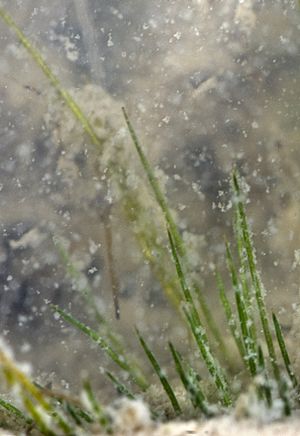Trithuria inconspicua facts for kids
Quick facts for kids Trithuria inconspicua |
|
|---|---|
| Scientific classification | |
| Genus: |
Trithuria
|
| Species: |
inconspicua
|
Trithuria inconspicua is a tiny water plant that looks like a grass. It belongs to the Hydatellaceae family and is only found in New Zealand. This special plant is sometimes called a "lily" because of how it grows underwater.
Contents
What is Trithuria inconspicua?
Trithuria inconspicua is a very small plant, only about 4 centimeters (1.5 inches) tall. It lives in fresh water lakes in New Zealand. You can find it growing deep underwater, usually between 5 and 7 meters (16 to 23 feet) down.
This plant grows in specific lakes in the Northland area of the North Island and the Fiordland area of the South Island. It often looks like small clumps of grass with thin roots. Most of the plant is hidden under mud or algae, with only the very tips of its leaves showing.
Male and Female Flowers
Trithuria inconspicua is a monoicous plant. This means that both male and female flowers can grow on the same plant. However, in nature, it's rare to find a single plant with both types of flowers.
- The male flowers are bright red and about 10 millimeters (less than half an inch) long.
- The female flowers are yellow-brown. They have 5 to 10 small parts called styles, which are grouped together at the top.
Different Types of Trithuria inconspicua
There are two main types, or subspecies, of Trithuria inconspicua:
- Trithuria inconspicua subspecies inconspicua: This type is found in the dune lakes of Northland, in the very north of New Zealand's North Island.
- Trithuria inconspicua subspecies brevistyla: This type lives in the cold, clear lakes formed by glaciers in the southern part of the South Island.
Is it the Oldest Flowering Plant?
Scientists are very interested in Trithuria inconspicua because it might be one of the oldest types of flowering plants on Earth!
For a long time, scientists thought that a woody shrub from New Caledonia called Amborella was the oldest flowering plant. This idea was based on studying its genes.
However, some newer studies have suggested that Trithuria inconspicua might actually be older. These studies looked at different parts of the plant's genes. If Trithuria inconspicua is the oldest, it would mean that the first flowering plants were soft, water-loving plants, not woody land plants like Amborella.
This debate among scientists is sometimes playfully called "wet and wild" (for the water plant idea) versus "dark and disturbed" (for the woody plant idea). It's an exciting mystery in the world of plants!
Why is Trithuria inconspicua Endangered?
Trithuria inconspicua is in serious danger. Its biggest threat comes from other plants that have been brought into New Zealand. One of these is the bladderwort (Utricularia gibba). This plant grows very fast and competes with Trithuria inconspicua for space and resources in the lakes. Many other invasive water weeds also threaten its survival.


